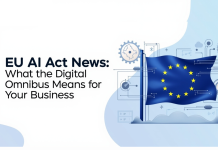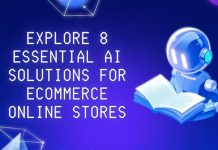For decades, the business world seemed to follow an unwritten rule: big brands win because they can afford more. More marketing dollars, more customer data, more sophisticated technology, and more specialized teams. Small businesses, no matter how passionate or innovative, often found themselves outgunned before they even entered the ring to compete with big brands.
But something remarkable is happening right now. The playing field is shifting beneath our feet, and artificial intelligence is the catalyst. What was once the exclusive playground of Fortune 500 companies—advanced automation, predictive analytics, personalized customer experiences—is now accessible to the local bakery, the independent online retailer, and the solo consultant working from their living room. AI isn’t just a buzzword anymore; it’s becoming the great equalizer in business competition.
This transformation isn’t theoretical. Small businesses worldwide are already wielding AI-powered tools to challenge competitors ten times their size. They’re delivering personalized experiences that rival Amazon’s, optimizing ad campaigns with the precision of multinational marketing departments, and making data-driven decisions that would have required entire analytics teams just five years ago. The competitive advantage that once belonged exclusively to those with deep pockets is now available to anyone with the curiosity to explore these new tools.
This article explores how small businesses are leveraging AI and digital marketing strategies to challenge big-brand dominance—and what lessons every business can learn from this remarkable shift.
Table of contents
- The Democratization of AI: From Enterprise Tech to Everyday Tool
- Smarter Customer Targeting through AI-Powered Digital Marketing
- AI-Driven Customer Service and Experience: The Hidden Differentiator
- Data Intelligence and Predictive Insights for Smarter Decisions
- Operational Efficiency and Automation: Doing More with Less
- Leveling the Playing Field: AI as a Brand Growth Multiplier to Compete with Big Brands
- Overcoming Barriers: Challenges and Solutions for Small Businesses
- Future Outlook: How AI Will Redefine Small Business Competition
- The Power Shift Has Begun
The Democratization of AI: From Enterprise Tech to Everyday Tool
Remember when “business intelligence software” meant spending hundreds of thousands on licenses and hiring specialized consultants? Those days are vanishing faster than you might think. AI has undergone one of the most dramatic democratization processes in technology history, transforming from an enterprise luxury to an everyday business necessity.
Just a decade ago, implementing AI meant massive upfront investments. Companies needed dedicated servers, expensive proprietary software, and teams of data scientists. The barrier to entry was measured in millions of dollars and years of development time. But the landscape has completely transformed. Cloud computing shattered the infrastructure requirements, making powerful computing accessible through monthly subscriptions rather than capital expenditures. Open-source frameworks like TensorFlow opened the door for developers to build accessible tools. And most importantly, a new generation of no-code and low-code platforms emerged, designed specifically for people without technical backgrounds.
Today’s small business owner can access AI capabilities through tools like ChatGPT for content creation, HubSpot’s AI features for marketing automation, Canva’s Magic Studio for design work, and Jasper for copywriting—all without needing to write a single line of code. A New Zealand based digital marketing agency can now deploy AI-driven campaign optimization tools that were simply unavailable to anyone outside enterprise corporations five years ago.
Key factors making AI accessible include:
- Cloud computing infrastructure that eliminates expensive hardware requirements
- Freemium AI tools offering powerful features at low or no cost
- Open-source frameworks democratizing AI development
- Increased awareness and adoption creating user-friendly interfaces
The cost reduction has been staggering. What once required a six-figure investment can now be accessed for less than the price of a decent coffee each day. This shift isn’t just about affordability—it’s about scalability. Small businesses can start with basic AI features and expand as they grow, paying only for what they use, allowing them to compete with big brands.
Smarter Customer Targeting through AI-Powered Digital Marketing
In the battle for customer attention, precision matters more than budget. This is where AI is fundamentally rewriting the rules of engagement, allowing small businesses to compete with big brands on intelligence rather than spending power.
Personalization at Scale to Compete with Big Brands
Big brands built their empires partly on personalization—making millions of customers feel individually recognized. For years, this seemed impossible for smaller players. How could a ten-person company deliver personalized experiences when they couldn’t afford the sophisticated customer relationship management systems and data analysts that giants like Netflix or Amazon employ?
AI has demolished that barrier. Predictive analytics now allows small businesses to understand customer preferences, anticipate needs, and tailor messages with remarkable accuracy. The local bookstore can recommend titles based on browsing history just like Amazon does. The neighborhood restaurant can send personalized menu suggestions based on past orders and dietary preferences. AI chatbots don’t just answer questions anymore—they learn individual customer preferences and offer genuinely useful, tailored recommendations.
Email marketing has evolved from broadcast messaging to sophisticated, behavior-triggered conversations. When a customer abandons their shopping cart, AI doesn’t just send a generic reminder—it analyzes why they might have left, what products they viewed, and what messaging is most likely to bring them back. This level of personalization was once the exclusive domain of enterprise marketing platforms costing thousands monthly. Now it’s available through affordable tools accessible to any small business.
Precision in Ad Spend Optimization
Every dollar matters when you’re working with a modest marketing budget and trying to compete with big brands. This is where AI’s analytical power becomes genuinely transformative. Traditional advertising often felt like throwing darts in the dark—you’d target broadly, hope for the best, and watch significant portions of your budget reach people who’d never become customers.
AI algorithms have brought scientific precision to ad targeting. Platforms like Google Ads now use machine learning to continuously optimize who sees your ads, when they see them, and what creative resonates most. Meta’s Advantage+ campaigns automatically test countless variations of targeting parameters, finding your ideal audience with an efficiency that would require dozens of human hours to replicate manually.
The benefit extends beyond just finding the right people. AI monitors campaign performance in real-time, automatically adjusting bids, reallocating budget to high-performing placements, and pausing underperforming elements. The result? Dramatically reduced wasted ad spend and significantly better return on investment. Small businesses now achieve conversion rates and cost-per-acquisition metrics that compete directly with their larger competitors.
Content Creation and Engagement
Content marketing requires consistency, quality, and volume—a combination that traditionally demanded either a large team or accepting mediocrity. AI-powered content tools have changed this equation entirely. Generative AI platforms help small businesses produce blog posts, social media updates, email newsletters, and even visual content at a pace that keeps them competitive with bigger brands’ content output.
But here’s what makes this truly valuable: these tools don’t just create volume—they maintain consistency. Your brand voice remains recognizable across platforms because tools like Jasper learn your tone and style. Visual coherence becomes achievable because platforms like Canva’s AI features understand your brand guidelines and apply them automatically. Grammar and readability tools ensure professional polish on every piece.
A New Zealand based digital marketing agency working with small businesses now has AI capabilities that enable clients to maintain content calendars and engagement rates that previously required dedicated content teams. The creative work remains human—the strategy, the insights, the unique perspectives—but AI handles the production scalability that makes consistent execution possible.
AI-Driven Customer Service and Experience: The Hidden Differentiator

Customer service often becomes the breaking point where small businesses struggle against larger competitors. Big brands offer 24/7 support, multiple contact channels, and instant responses. How could a small team possibly compete with big brands? Enter AI-powered customer service tools, which have become perhaps the most practical application of artificial intelligence for smaller businesses.
Modern AI chatbots have evolved far beyond the frustrating, script-following bots of the past. Today’s virtual assistants handle complex conversations, understand context, learn from interactions, and genuinely solve problems. They answer frequently asked questions, process bookings, track orders, and even handle basic troubleshooting—all without human intervention and available round-the-clock.
Consider a small e-commerce business that implemented an AI chatbot to handle initial customer inquiries. Response time dropped from hours (when staff were available) to seconds (any time of day). Customer satisfaction scores improved because people got immediate help, even at 2 AM. The business owner freed up countless hours previously spent answering repetitive questions, redirecting that energy toward growth initiatives.
AI sentiment analysis adds another powerful dimension. These tools analyze customer feedback across reviews, social media, and support interactions, identifying emotional patterns and emerging concerns. A small hospitality business can spot dissatisfaction trends early—perhaps guests are consistently mentioning noise issues or praising a particular amenity—and respond proactively before minor issues become reputation problems.
The benefits compound quickly:
- Faster response times that compete with big brand standards
- Improved customer satisfaction through always-available support
- Lower operational costs by automating routine inquiries
- Better staff utilization focusing human expertise on complex issues
The hidden advantage here isn’t just matching big brands—it’s sometimes exceeding them. Many large companies‘ AI implementations feel corporate and impersonal. Small businesses can configure their AI tools to reflect genuine brand personality, creating automated experiences that still feel authentically human and locally connected.
Data Intelligence and Predictive Insights for Smarter Decisions
Data used to be a big-brand superpower. Large corporations invested millions in business intelligence teams, sophisticated analytics platforms, and data warehouses. They made decisions based on comprehensive insights while small businesses relied largely on intuition and limited spreadsheet analysis.
AI-powered analytics tools have fundamentally disrupted this advantage. Modern platforms gather data from multiple sources—website traffic, social media engagement, sales transactions, customer service interactions—and interpret it all through machine learning algorithms that identify patterns human analysts might miss.
Predictive models represent perhaps the most valuable evolution. These systems don’t just report what happened; they forecast what’s likely to happen next. A small retail business can predict seasonal demand fluctuations, identify which products will trend upward, and optimize inventory accordingly. A service business can forecast client acquisition costs and lifetime value, making smarter decisions about where to invest marketing resources.
Tools like Zoho Analytics, Pecan AI, and Tableau with AI integration have made enterprise-grade analytics accessible at small-business price points. The insights generated reduce the guesswork that once characterized small business strategy. When should you launch that new product? Which customer segment offers the highest growth potential? What pricing strategy will maximize both volume and margins? AI-driven analytics provides data-backed answers to questions that previously required expensive consultants or educated guessing.
The operational impact is profound. Small businesses can now compete with big brands on strategic sophistication, making decisions with the same empirical foundation that drives big-brand planning. The playing field hasn’t just leveled—in some cases, nimble small businesses can actually outmaneuver larger competitors because they can implement insights faster, without the bureaucratic delays that slow enterprise decision-making. This new accessibility empowers them to truly compete with big brands on multiple fronts.
Operational Efficiency and Automation: Doing More with Less
Small business owners wear many hats—often too many. The day fills with administrative tasks: sending invoices, scheduling appointments, following up on leads, managing inventory, processing orders. These necessary activities consume time that could be spent on strategy, customer relationships, and growth initiatives. AI-powered automation is changing this fundamental constraint.
Workflow automation has matured remarkably. Email sequences trigger based on customer actions. Invoicing systems generate and send bills automatically when services are delivered. Scheduling tools coordinate appointments without the back-and-forth email tennis. These aren’t revolutionary capabilities individually, but collectively they return hours to business owners’ schedules each week.
Inventory management showcases AI’s practical impact. Small retailers can now deploy systems that monitor stock levels, predict reorder points based on seasonal patterns and sales velocity, and even automate purchase orders with suppliers. Supply chain forecasting helps prevent both stockouts and overstock situations—problems that directly impact cash flow and customer satisfaction.
Human resources processes benefit enormously from AI assistance. Resume screening tools identify qualified candidates from application pools, saving hours of manual review. Onboarding automation guides new employees through paperwork and initial training. Shift scheduling algorithms optimize staff coverage based on predicted demand patterns.
The advantages compound:
- Significant time savings on repetitive administrative tasks
- Reduced labor costs through operational efficiency
- Improved accuracy by eliminating manual data entry errors
- Enhanced scalability without proportional staff increases
Case Insight
Consider a small online retailer selling specialty home goods and trying to compete with big brands. By implementing AI-driven order fulfillment automation, they achieved delivery efficiency that matches big-brand standards. The system automatically routes orders to the optimal warehouse location, selects the most cost-effective shipping method based on destination and urgency, generates tracking information, and sends customer updates—all without human intervention. What previously required dedicated staff now happens seamlessly, allowing the business to scale order volume without scaling operational costs proportionally.
Leveling the Playing Field: AI as a Brand Growth Multiplier to Compete with Big Brands

Brand building once required massive advertising budgets and widespread media presence. Big brands dominated consumer consciousness simply because they could afford to be everywhere. AI is rewriting this narrative by helping small businesses amplify their presence, credibility, and competitiveness through intelligence rather than spending power.
Social media marketing transformed with AI-driven analytics that predict emerging trends before they peak. Small businesses can identify viral content patterns, optimal posting times, and engagement tactics that maximize organic reach. This proactive approach replaces the reactive strategy of simply posting content and hoping it finds an audience.
Better storytelling emerges when AI tools analyze what resonates with specific audience segments. The insights inform content strategy, helping small brands craft narratives that connect emotionally while addressing practical customer needs. Brand positioning becomes more precise when you understand exactly how your audience perceives you compared to competitors, information that AI sentiment analysis readily provides.
Influencer marketing, once prohibitively expensive to execute well, becomes accessible through AI-powered discovery tools. These platforms identify micro-influencers whose audiences perfectly match your target demographic, predict engagement rates, and even suggest collaboration approaches based on successful past partnerships in your industry.
The compounding effect is remarkable. When digital marketing powered by AI helps small brands appear as polished and professional as larger competitors, consumers increasingly make purchasing decisions based on value and connection rather than brand size. A well-executed AI-enhanced brand presence signals competence, modernity, and customer focus—qualities that matter more than company size to today’s consumers.
Key takeaway: AI doesn’t just save money—it fundamentally enhances brand perception and extends reach. The local business that leverages these tools effectively can build brand equity that competes directly with regional or even national players in their space.
Overcoming Barriers: Challenges and Solutions for Small Businesses
Despite AI’s accessibility, real obstacles prevent many small businesses from capturing its benefits. Understanding these barriers and their practical solutions makes the difference between theoretical possibility and actual implementation.
Common challenges include:
Limited AI literacy represents the most significant hurdle. Many business owners feel overwhelmed by technology, uncertain where to start, or intimidated by terminology. The learning curve seems steep when you’re already stretched thin managing daily operations.
Data privacy concerns create legitimate hesitation. Small businesses worry about customer data security, compliance with regulations like GDPR, and the reputational damage potential breaches could cause. These fears often lead to analysis paralysis—better to avoid AI entirely than risk data problems.
Tool overload compounds the confusion. Hundreds of AI platforms promise transformation, making selection difficult. Integration challenges emerge when different tools don’t communicate effectively, creating data silos rather than unified insights.
The upfront time investment feels prohibitive. Implementing and learning new systems demands hours that busy owners struggle to find, even when they recognize long-term benefits.
Practical solutions exist for each barrier:
Start small with a single, specific process rather than attempting comprehensive AI transformation. Perhaps begin with marketing automation to nurture leads more effectively, or implement a chatbot to handle routine customer questions. Early wins build confidence and demonstrate value, making subsequent expansions easier.
Use free trials and freemium AI tools to explore capabilities without financial risk. Most platforms offer robust free tiers that allow thorough testing before committing budget. This approach reduces both financial and psychological barriers to experimentation.
Focus relentlessly on measurable outcomes rather than features. Don’t ask whether a tool has impressive AI capabilities—ask whether it improves your conversion rate, generates more qualified leads, or reduces customer service costs. This outcome-orientation cuts through marketing hype to identify genuinely valuable applications.
Invest strategically in training or partner with consultants who understand both AI capabilities and small business realities. Sometimes a few hours with an expert accelerates learning by months, helping you avoid costly missteps and implement systems correctly from the start. Working with specialists like a New Zealand based digital marketing agency that understands AI integration for smaller businesses can bridge the knowledge gap efficiently.
The path forward isn’t about becoming an AI expert—it’s about becoming comfortable enough to leverage these tools strategically. Small, measured steps consistently applied generate momentum that makes advanced applications feel natural rather than overwhelming.
Future Outlook: How AI Will Redefine Small Business Competition
The AI revolution in small business is still in its early chapters. Understanding where this technology is heading helps business owners prepare for opportunities rather than scramble to catch up.
AI evolution is moving from reactive to proactive systems. Current tools mostly respond to human prompts and requests. Next-generation AI will anticipate needs, suggest strategies unprompted, and autonomously optimize processes in real-time. Imagine marketing systems that don’t just execute campaigns you design but propose entirely new approaches based on emerging market patterns they detect before human analysts notice them.
Hyper-personalization will become the baseline expectation rather than a competitive advantage. As AI capabilities mature, every customer interaction—from website visits to email communications to product recommendations—will adapt dynamically to individual preferences, contexts, and needs. The small business that delivers generic experiences will feel as outdated as a company without a website feels today.
Integration with emerging technologies will expand AI’s impact dramatically. Augmented reality shopping experiences powered by AI recommendations, voice search optimization that understands natural conversation, and Internet of Things devices that provide real-time customer insight will all become accessible to small businesses. The convergence of these technologies creates possibilities we’re only beginning to imagine.
Real-time marketing will shift from aspiration to standard practice. AI systems will monitor brand mentions, competitive moves, and market shifts continuously, enabling small businesses to respond instantly to opportunities or challenges. The agility advantage that small businesses naturally possess will multiply when paired with AI-powered market intelligence, helping them compete with big brands more effectively than ever before.
The Power Shift Has Begun
The transformation is already underway. AI and digital marketing together are fundamentally changing how small businesses compete with big brands, eliminating barriers that once seemed permanent and insurmountable. The traditional big-brand advantages—superior data analytics, personalized customer experiences, operational efficiency, 24/7 customer service, sophisticated marketing optimization—are no longer exclusive territories.
Access to AI tools has erased much of the “big brand advantage” that defined competitive dynamics for generations. A small business with strategic intelligence can now deliver customer experiences that rival or exceed what large corporations offer. The solo entrepreneur can make data-driven decisions with the same empirical foundation that guides multinational strategies. The local retailer can optimize operations with efficiency that matches national chains.
But here’s the truly exciting insight: AI isn’t replacing human creativity, intuition, or relationship-building skills. Instead, it’s amplifying these inherently human capabilities, removing the operational constraints that previously limited their expression. Small businesses can now compete with big brands smarter, not just harder—leveraging AI to handle scalability and analytical complexity while focusing human energy on creativity, strategy, and authentic customer connections.











